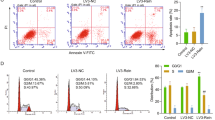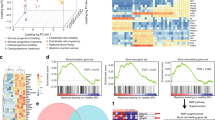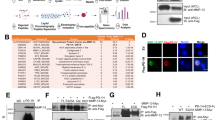Abstract
We describe a new model of myeloma bone disease in which β2m NOD/SCID mice injected with KMS-12-BM cells develop medullary disease after tail vein administration. Micro-computed tomography analysis demonstrated significant bone loss in the tibiae and vertebrae of diseased animals compared to controls, with loss of cortical bone (P<0.01), as well as trabecular bone volume, thickness and number (P<0.05 for all). Bone marrow of diseased animals demonstrated an increase in osteoclasts (P<0.01) and reduction in osteoblasts (P<0.01) compared to control animals. Both bone loss and osteoclast increase correlated with the degree of disease involvement. Mesenchymal stem cells (MSCs) were lentivirally transduced to express human osteoprotegerin (hOPG). Systemic administration of OPG expressing MSC reduced osteoclast activation (P<0.01) and trabecular bone loss in the vertebrae (P<0.05) and tibiae of diseased animals, to levels comparable to non-diseased controls. Because of its predominantly medullary involvement and quantifiable parameters of bone disease, the KMS-12-BM xenogeneic model provides unique opportunities to test therapies targeted at the bone marrow microenvironment.
This is a preview of subscription content, access via your institution
Access options
Subscribe to this journal
Receive 12 print issues and online access
$259.00 per year
only $21.58 per issue
Buy this article
- Purchase on Springer Link
- Instant access to full article PDF
Prices may be subject to local taxes which are calculated during checkout





Similar content being viewed by others
References
Roodman GD . Mechanisms of bone lesions in multiple myeloma and lymphoma. Cancer 1997; 80 (8 Suppl): 1557–1563.
Bataille R, Chappard D, Marcelli C, Dessauw P, Baldet P, Sany J et al. Recruitment of new osteoblasts and osteoclasts is the earliest critical event in the pathogenesis of human multiple myeloma. J Clin Invest 1991; 88: 62–66.
Taube T, Beneton MN, McCloskey EV, Rogers S, Greaves M, Kanis JA . Abnormal bone remodelling in patients with myelomatosis and normal biochemical indices of bone resorption. Eur J Haematol 1992; 49: 192–198.
Kong YY, Yoshida H, Sarosi I, Tan HL, Timms E, Capparelli C et al. OPGL is a key regulator of osteoclastogenesis, lymphocyte development and lymph-node organogenesis. Nature 1999; 397: 315–323.
Anderson DM, Maraskovsky E, Billingsley WL, Dougall WC, Tometsko ME, Roux ER et al. A homologue of the TNF receptor and its ligand enhance T-cell growth and dendritic-cell function. Nature 1997; 390: 175–179.
Simonet WS, Lacey DL, Dunstan CR, Kelley M, Chang MS, Luthy R et al. Osteoprotegerin: a novel secreted protein involved in the regulation of bone density. Cell 1997; 89: 309–319.
Pearse RN, Sordillo EM, Yaccoby S, Wong BR, Liau DF, Colman N et al. Multiple myeloma disrupts the TRANCE/osteoprotegerin cytokine axis to trigger bone destruction and promote tumor progression. Proc Natl Acad Sci USA 2001; 98: 11581–11586.
Giuliani N, Bataille R, Mancini C, Lazzaretti M, Barille S . Myeloma cells induce imbalance in the osteoprotegerin/osteoprotegerin ligand system in the human bone marrow environment. Blood 2001; 98: 3527–3533.
Seidel C, Hjertner O, Abildgaard N, Heickendorff L, Hjorth M, Westin J et al. Serum osteoprotegerin levels are reduced in patients with multiple myeloma with lytic bone disease. Blood 2001; 98: 2269–2271.
Choi SJ, Cruz JC, Craig F, Chung H, Devlin RD, Roodman GD et al. Macrophage inflammatory protein 1-alpha is a potential osteoclast stimulatory factor in multiple myeloma. Blood 2000; 96: 671–675.
Giuliani N, Colla S, Morandi F, Lazzaretti M, Sala R, Bonomini S et al. Myeloma cells block RUNX2/CBFA1 activity in human bone marrow osteoblast progenitors and inhibit osteoblast formation and differentiation. Blood 2005; 106: 2472–2483.
Tian E, Zhan F, Walker R, Rasmussen E, Ma Y, Barlogie B et al. The role of the Wnt-signaling antagonist DKK1 in the development of osteolytic lesions in multiple myeloma. N Engl J Med 2003; 349: 2483–2494.
Giuliani N, Rizzoli V, Roodman GD . Multiple myeloma bone disease: pathophysiology of osteoblast inhibition. Blood 2006; 108: 3992–3996.
Croucher PI, Shipman CM, Lippitt J, Perry M, Asosingh K, Hijzen A et al. Osteoprotegerin inhibits the development of osteolytic bone disease in multiple myeloma. Blood 2001; 98: 3534–3540.
Choi SJ, Oba Y, Gazitt Y, Alsina M, Cruz J, Anderson J et al. Antisense inhibition of macrophage inflammatory protein 1-alpha blocks bone destruction in a model of myeloma bone disease. J Clin Invest 2001; 108: 1833–1841.
Huang YW, Richardson JA, Tong AW, Zhang BQ, Stone MJ, Vitetta ES . Disseminated growth of a human multiple myeloma cell line in mice with severe combined immunodeficiency disease. Cancer Res 1993; 53: 1392–1396.
Alsina M, Boyce B, Devlin RD, Anderson JL, Craig F, Mundy GR et al. Development of an in vivo model of human multiple myeloma bone disease. Blood 1996; 87: 1495–1501.
Tsunenari T, Koishihara Y, Nakamura A, Moriya M, Ohkawa H, Goto H et al. New xenograft model of multiple myeloma and efficacy of a humanized antibody against human interleukin-6 receptor. Blood 1997; 90: 2437–2444.
Hjorth-Hansen H, Seifert MF, Borset M, Aarset H, Ostlie A, Sundan A et al. Marked osteoblastopenia and reduced bone formation in a model of multiple myeloma bone disease in severe combined immunodeficiency mice. J Bone Miner Res 1999; 14: 256–263.
Yaccoby S, Barlogie B, Epstein J . Primary myeloma cells growing in SCID-hu mice: a model for studying the biology and treatment of myeloma and its manifestations. Blood 1998; 92: 2908–2913.
Yata K, Yaccoby S . The SCID-rab model: a novel in vivo system for primary human myeloma demonstrating growth of CD138-expressing malignant cells. Leukemia 2004; 18: 1891–1897.
Turley H, Jones M, Erber W, Mayne K, de Waele M, Gatter K . VS38: a new monoclonal antibody for detecting plasma cell differentiation in routine sections. J Clin Pathol 1994; 47: 418–422.
Hanawa H, Kelly PF, Nathwani AC, Persons DA, Vandergriff JA, Hargrove P et al. Comparison of various envelope proteins for their ability to pseudotype lentiviral vectors and transduce primitive hematopoietic cells from human blood. Mol Ther 2002; 5: 242–251.
Ahmed F, Ings SJ, Pizzey AR, Blundell MP, Thrasher AJ, Ye HT et al. Impaired bone marrow homing of cytokine-activated CD34+ cells in the NOD/SCID model. Blood 2004; 103: 2079–2087.
Ohtsuki T, Yawata Y, Wada H, Sugihara T, Mori M, Namba M . Two human myeloma cell lines, amylase-producing KMS-12-PE and amylase-non-producing KMS-12-BM, were established from a patient, having the same chromosome marker, t(11;14)(q13;q32). Br J Haematol 1989; 73: 199–204.
Kyriakou CA, Yong KL, Benjamin R, Pizzey A, Dogan A, Singh N et al. Human mesenchymal stem cells (hMSCs) expressing truncated soluble vascular endothelial growth factor receptor (tsFlk-1) following lentiviral-mediated gene transfer inhibit growth of Burkitt's lymphoma in a murine model. J Gene Med 2006; 8: 253–264.
Christianson SW, Greiner DL, Hesselton RA, Leif JH, Wagar EJ, Schweitzer IB et al. Enhanced human CD4+ T cell engraftment in beta2-microglobulin-deficient NOD-scid mice. J Immunol 1997; 158: 3578–3586.
Vanderkerken K, De Leenheer E, Shipman C, Asosingh K, Willems A, Van Camp B et al. Recombinant osteoprotegerin decreases tumor burden and increases survival in a murine model of multiple myeloma. Cancer Res 2003; 63: 287–289.
Sordillo EM, Pearse RN . RANK-Fc: a therapeutic antagonist for RANK-L in myeloma. Cancer 2003; 97 (3 Suppl): 802–812.
Body JJ, Greipp P, Coleman RE, Facon T, Geurs F, Fermand JP et al. A phase I study of AMGN-0007, a recombinant osteoprotegerin construct, in patients with multiple myeloma or breast carcinoma related bone metastases. Cancer 2003; 97 (3 Suppl): 887–892.
Doran PM, Turner RT, Chen D, Facteau SM, Ludvigson JM, Khosla S et al. Native osteoprotegerin gene transfer inhibits the development of murine osteolytic bone disease induced by tumor xenografts. Exp Hematol 2004; 32: 351–359.
Tricot G . New insights into role of microenvironment in multiple myeloma. Lancet 2000; 355: 248–250.
Pittenger MF, Mackay AM, Beck SC, Jaiswal RK, Douglas R, Mosca JD et al. Multilineage potential of adult human mesenchymal stem cells. Science 1999; 284: 143–147.
Liechty KW, MacKenzie TC, Shaaban AF, Radu A, Moseley AM, Deans R et al. Human mesenchymal stem cells engraft and demonstrate site-specific differentiation after in utero transplantation in sheep. Nat Med 2000; 6: 1282–1286.
Horwitz EM, Prockop DJ, Fitzpatrick LA, Koo WW, Gordon PL, Neel M et al. Transplantability and therapeutic effects of bone marrow-derived mesenchymal cells in children with osteogenesis imperfecta. Nat Med 1999; 5: 309–313.
Koc ON, Peters C, Aubourg P, Raghavan S, Dyhouse S, DeGasperi R et al. Bone marrow-derived mesenchymal stem cells remain host-derived despite successful hematopoietic engraftment after allogeneic transplantation in patients with lysosomal and peroxisomal storage diseases. Exp Hematol 1999; 27: 1675–1681.
Khakoo AY, Pati S, Anderson SA, Reid W, Elshal MF, Rovira II et al. Human mesenchymal stem cells exert potent antitumorigenic effects in a model of Kaposi's sarcoma. J Exp Med 2006; 203: 1235–1247.
Studeny M, Marini FC, Champlin RE, Zompetta C, Fidler IJ, Andreeff M . Bone marrow-derived mesenchymal stem cells as vehicles for interferon-beta delivery into tumors. Cancer Res 2002; 62: 3603–3608.
Nakamizo A, Marini F, Amano T, Khan A, Studeny M, Gumin J et al. Human bone marrow-derived mesenchymal stem cells in the treatment of gliomas. Cancer Res 2005; 65: 3307–3318.
Yaccoby S, Wezeman MJ, Zangari M, Walker R, Cottler-Fox M, Gaddy D et al. Inhibitory effects of osteoblasts and increased bone formation on myeloma in novel culture systems and a myelomatous mouse model. Haematologica 2006; 91: 192–199.
Author information
Authors and Affiliations
Corresponding author
Rights and permissions
About this article
Cite this article
Rabin, N., Kyriakou, C., Coulton, L. et al. A new xenograft model of myeloma bone disease demonstrating the efficacy of human mesenchymal stem cells expressing osteoprotegerin by lentiviral gene transfer. Leukemia 21, 2181–2191 (2007). https://doi.org/10.1038/sj.leu.2404814
Received:
Accepted:
Published:
Issue Date:
DOI: https://doi.org/10.1038/sj.leu.2404814
Keywords
This article is cited by
-
The roles of osteoprotegerin in cancer, far beyond a bone player
Cell Death Discovery (2022)
-
Mesenchymal stem cells in multiple myeloma: a therapeutical tool or target?
Leukemia (2018)
-
Genetic factors influencing the risk of multiple myeloma bone disease
Leukemia (2016)
-
Tracking human multiple myeloma xenografts in NOD-Rag-1/IL-2 receptor gamma chain-null mice with the novel biomarker AKAP-4
BMC Cancer (2011)
-
The Hemopoietic Stem Cell Niche Versus the Microenvironment of the Multiple Myeloma-Tumor Initiating Cell
Cancer Microenvironment (2010)



